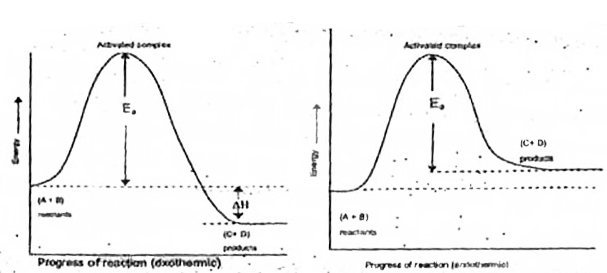A collision between high energy molecules overcomes the forces of repulsion and brings the formation of an unstable molecule cluster, called activated complex. The life span of an activatd complex is very small. Thus, the activated complex breaks either into reactants again or new substances, i.e. products. The activation energy (Ea) depends upon the nature of chemical bonds undergoing rupture and is independent of enthalpies of reactants and products. The energy changes during exothermic and endothermic versus the progress of the reaction are as shown below :

When temperature is increased, the number of active molecule increases, i.e. the number of effective collisions will increase and the rate of reaction will increase.
Activation energy (Ea)=E(activated complex)−E(ground state)
ΔH=Ea(f)−Ea(b)
The activation energy for the forward reaction , X→Y, is 60kJmol−1 and ΔH is −20kJ/mol−1, the activation energy for the reverse reaction is
40kJ/mol
60kJ/mol
80kJ/mol
20kJ/mol
The correct Answer is:C
Topper's Solved these Questions
- CHEMICAL KINETICS AND RADIOACTIVITYBOOK - FIITJEECHAPTER - CHEMICAL KINETICS AND RADIOACTIVITYEXERCISE - Assignment problems (Objective) Level-II (Comprehension-V)
5 Videos
- CHEMICAL KINETICS AND RADIOACTIVITYBOOK - FIITJEECHAPTER - CHEMICAL KINETICS AND RADIOACTIVITYEXERCISE - Matching list type question
3 Videos
- CHEMICAL KINETICS AND RADIOACTIVITYBOOK - FIITJEECHAPTER - CHEMICAL KINETICS AND RADIOACTIVITYEXERCISE - Assignment problems (Objective) Level-II (Comprehension-III )
4 Videos
- CHEMICAL EQUILIBRIUMBOOK - FIITJEECHAPTER - CHEMICAL EQUILIBRIUMEXERCISE - MATCHING TYPE QUESTIONS
3 Videos
- CHEMISTRY IN EVERY DAY LIFE BOOK - FIITJEECHAPTER - CHEMISTRY IN EVERY DAY LIFE EXERCISE - ASSIGNMENT PROBLEMS (OBJECTIVE) Level - II (Numerical Based Questions)
5 Videos
Similar Questions
When the temperature is increased, heat is supplied which increases the kinetic energy of the reacting molecules. This shall increase the number of collisions and ultimately the rate of reaction shall be enhanced. Arrhenius suggested a equation which describes K as a function of temperature, i.e.
k=Ae−Ea/RT
where
k= rate constant
A= a constant (frequency factor)
Ea= energy of activation
log10k=log10A−Ea2.303R[1R]
Y=C+MX
It is the equation of straight line with negative slope. On plotting log10k against [1T] we get a straight line as shown below :

The slope gives activation energy and intercept gives frequency factor.
Also log.k2k1=Ea2.303[T2−T1T1T2]
The rate constant of a reaction is increased by 5% when its temperature is raised from 27∘C to 28∘C . The activation energy of the reaction in kJ/mol is
View Solution
View SolutionThe quantity of .14C as well as that of .14CO2 present in the atmosphere remains constant. The concentration of .14C in all living organisms remains almost constant during their life time. After their death, .14C is not taken up by them but the content of .14C assimilated begins to decay by emitting β− particles, with half-life period of 5568 years. The decay rate at the time of death of plant is 16.1counts per minute per gram of carbon. Hence, by measuring the decay rate of the dead matter, the age of matter can be calculated , e.g. if decay rate of sample of wood is found to be N distengrations per minute per gram of carbon after t years, then N=N0e−λt
where λ= disntegration constant and
N0= number of disntegrations per minute per gram when the plant had just died.
.14C is present in environmental because of
View Solution

Which of the following combination is correct ?
View SolutionHow many of the following are water soluble vitamins ?
A, B, C, D , K, E
View SolutionThe activation energy of reactant molecules in a reaction depends upon
View SolutionAccording to the tranistion state theory, for the formation of on activation complex, one of the vibrational degree of freedom is converted into the tranistion degree of freedom. Reason (R ): The energy of the activated complex is higher than the energy of the reactant molecules.
View SolutionThe difference of energy between activated complex and that of the reactants is called ……………… .
View SolutionStatement: According transition state theory for the formation of an activated complex, one of the vibrational degree of freedom is converted into a transitional degree of freedom. Explanation: Energy of the the activated complex is higher than the energy of reactant molecules.
View SolutionAssertion: According to transition state theory, for the formation of an activated complex, one of the vibrational degree of freedom is converted into a translation degree of freedom.
Reason: Energy of the activated complex is higher than the energy of the reactant molecules.
View SolutionAssertion: According to the transition state theory, for the formation of an activated complex, one of the vibrational degree of freeedom is converted into the transition degree of freedom. Reason: The energy of the activated complex is higher than the energy of the reactant molecules.
View SolutionIn the accompanied diagram E_(R), E_(P) and E_(X) represents the energy of the reactants products and activated complex respectively Which of the following is the activation energy for the backward reaction?
View SolutionAssertion: According to transition state theory for the formation of an activated complex, one of the vibrational degree of freedom is converted into a transitional degree of freedom.
Reason: Energy of the activated complex is higher than the energy of reactant molecules.
View SolutionThe difference between the energy of the activated complex and the average energy of the reactants is called………………… .
View SolutionAssertion. According to transition state theory, for the formation of an activated complex, one of the vibrational degree of freedom is converted into a translational degree of freedom. Reason. Energy of the activated complex is higher than the energy of the reactant molecules.
View Solution
